Abstract
Flax–gypsum composites are an emerging class of environmentally friendly materials that combine the mechanical properties of gypsum with the advantageous characteristics of flax fibers. The production of flax–gypsum composites involve the incorporation of flax fibers, derived from the flax plant, into gypsum matrix systems. In order to create a uniform distribution of fibers within the gypsum matrix, the hand lay-up approach has been used to produce the specimens. The fiber content and orientation significantly influence the resulting mechanical and physical properties of the composites. Various tests were conducted on the samples, such as a flexural test, a compression test, a density test, a water absorption test, and a microscopy test. The addition of flax fibers imparts several desirable properties to the gypsum matrix. When combined with gypsum, these fibers enhanced the composite’s mechanical properties, such as flexural strength and compressive strength. The results indicated improved compression and flexural strengths due to effective load transfer within the matrix, for up to 10% of fiber loading. A decrease in composite density upon flax fiber addition results in a lighter material, enabling insights for various applications.
1. Introduction
Due to growing ecological concerns, the development of new materials and products now thoroughly considers factors like environmental safety and recyclability. This shift has sparked increased interest in natural fibers, which have become a crucial component of environmentally friendly materials in the building industry over the last decade. Plant fibers such as flax, hemp, sisal, and kenaf are being viewed as reasonably priced and ecologically suitable substitutes for glass fibers [1,2]. Among these, flax fibers stand out due to their excellent mechanical properties, recyclability, and affordability, making them the most widely used plant fibers in composite materials [3].
Gypsum, known for its unique properties and appealing appearance, has emerged as the preferred material in the construction sector. Gypsum’s hydration is significantly influenced by water content, and agents that accelerate or retard this process effectively control its setting rate [4]. Introducing fibers into gypsum transforms its brittle nature into a pseudo-ductile behavior [5,6]. Utilizing flax fibers in gypsum presents potential environmental benefits by reducing the carbon footprint and energy consumption during production [7]. Considering the durability and longevity they offer, incorporating flax fibers into gypsum could also potentially be cost-effective [8].
Methods like alkali treatment, acetylation treatment, and permanganate treatment are commonly used to modify the molecular structure of fiber materials, enhancing their performance [8,9]. Short fibers in the composite decrease crack propagation along the fiber–matrix interface [10,11]. Evaluating mechanical properties, Hoálková et al. discovered that a higher amount of wooden fibers in gypsum composites reduces the compressive and flexural strength [12]. Wei, J. et al. suggested that improving fiber-matrix bonding requires compatibilizer treatment [13].
Iucolano, F. et al. examined recycled plastic aggregates in mortar composition and explored different methods, such as dispersing flax fibers randomly into gypsum slurry and molding them [14]. Ali, M. et al. investigated the mechanical and dynamic properties of coconut fiber-reinforced concrete, showing that the laminated mat method uses flax fiber mats between gypsum plaster layers to create a laminate [15]. Ardanuy, M. et al. found that dimensional stability issues in cellulosic fiber-reinforced cement-based composites were due to flax’s high water absorption, causing swelling [16]. Nindiyasari et al. observed that adding cellulose content increased the bending strength, compressive strength, and Young’s modulus in cellulose fiber-reinforced gypsum composites [17]. Ali, M.A. et al. analyzed the improvement of mechanical properties in glass fiber-reinforced gypsum composites [18].
The combination of flax and gypsum in composite materials presents a high-performance and eco-friendly alternative to synthetic fiber-reinforced gypsum, offering unique benefits for sustainable construction. This study aims to investigate the mechanical characteristics of gypsum composites reinforced with flax fibers treated with NaOH solution, exploring the impact of different volume fractions and fiber lengths on the overall compatibility of flax fibers with gypsum.
2. Materials and Methods
2.1. Materials
Gypsum binder (calcium sulfate hemihydrate) with a density of 2.62 g/cm3 was utilized as the matrix, and was ordered from the Hammer Fachmarkt in Pirmasens, Germany. Flax fibers were used as the reinforcement. They were supplied by Etsy GmbH, Berlin, Germany, with a density of 1.47 g/cm3, and were unbleached with 100% linen. Flax fiber has an average mean diameter of 175 µm. A 2 wt.-% solution of NaOH was provided by Carl Roth Gmbh, Karlsruhe, Germany.
2.2. Methods
2.2.1. Alkali Treatment and Chopping of Fibers
The alkali treatment increases the mechanical characteristics of the fiber as well as the physical properties of composites [8,9]. By removing hemicelluloses from the fiber, it would be possible to improve the load distribution by having the fibrils line up with the direction of stress. Alkali treatment increases the effectiveness of accessible hydroxyl groups by removing non-cellulosic components that cover the hydroxyl groups in cellulose. After the fiber’s surface has been cleaned of impurities, a clean, rough surface with many pits is revealed, significantly increasing the surface area of the fiber. A rougher surface allows for better mechanical bonding to gypsum. The required amount of flax fibers was treated for 30 min with a 2 wt.-% NaOH solution to eliminate the soluble oily components. The surplus NaOH was then completely rinsed out of the fibers with water. The fibers were then allowed to dry at room temperature for 24 h. After the alkali treatment, flax fibers were chopped into two different sizes, such as 10 mm and 20 mm, respectively, before being reinforced into the matrix.
2.2.2. Formation of Gypsum
Gypsum (calcium sulfate dihydrate, CaSO4·2H2O) can be formed by hydrating calcium sulfate hemihydrate (CaSO4·0.5 H2O) [4]. Gypsum can be converted back into calcium sulfate hemihydrate by removing the water molecules from its structure. This process is known as dehydration. It typically occurs when gypsum is exposed to high temperatures.
The dehydration of gypsum can be represented by the following equation:
CaSO4·2 H2O → CaSO4·0.5 H2O + 1.5 H2O
The hydration of gypsum can be represented by the following equation:
CaSO4·0.5 H2O + 1.5 H2O → CaSO4·2H2O
2.2.3. Preparation of Wooden Molds
Wooden molds were prepared to fill the flax–gypsum slurry. These molds were made according to the sample dimensions specified in the test standards. The dimensions of the molds were of two types.
Type 1 has an inner dimension of 160 × 130 × 18 mm, and type 2 has an inner dimension of 160 × 40 × 40 mm. Samples produced from the type 1 mold were used for density and water absorption tests, and samples produced from the type 2 mold were used for compression and flexural tests, as shown in Figure 1.
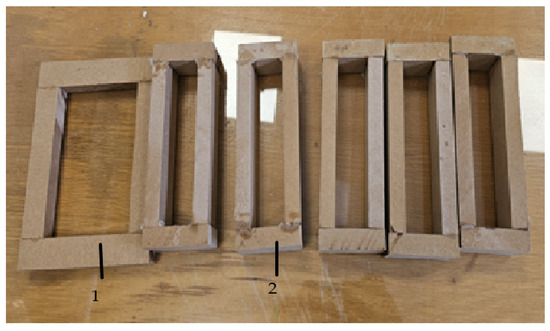
Figure 1.
Types of molds (1), (2).
2.3. Sample Preparation
The hand lay-up method was adopted to fill the prepared wooden molds. Flax fibers in the form of yarn were taken, ensuring they were clean and free from any impurities. The flax fibers were treated using a NaOH solution and dried for 24 h. The flax fibers were then cut to the desired lengths, such as 10 mm or 20 mm. Fibers and the gypsum binder were taken into a container according to their respective masses and mixed thoroughly. After mixing these two components, water was added to the container. The water content was 0.6 times the weight of the gypsum binder. Stirring continued until a uniform distribution of flax fibers in the gypsum paste was achieved. The pre-mixed mixture was poured into the molds. The composites were allowed to cure, typically for about 48 to 72 h, to ensure better curing. Then, after composites were kept out in a controlled environment with moderate temperature and humidity, they were placed under the sun for a week [12]. Once they had cured, the composites were carefully removed from the molds as shown in Figure 2. This procedure was followed for all the remaining specimens.
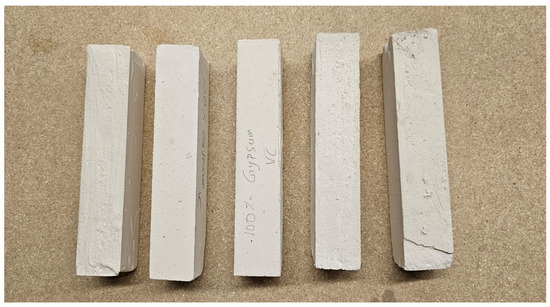
Figure 2.
Samples produced.
Volume fraction calculations of Table 1 were calculated using the formula given below:
where ∅f—fiber volume fraction, wf—fiber weight fraction, ρf—fiber density, wm—matrix weight fraction, and ρm—matrix density. The value of the density of the gypsum binder and flax are given in Section 2.1.

Table 1.
Compositions of flax–gypsum in vol.-% with 10 mm and 20 mm fiber lengths.
2.4. Experimental Test Setup
2.4.1. Mechanical Tests
For flexural and compression tests, a rectangular gypsum composite specimen was produced and tested according to the standard EN 13279-2. Flexural and compression tests were conducted on a Zwick/Roell universal testing machine. For the determination of the flexural strength, specimens produced with a dimension of 160 × 40 × 40 mm were used. The compression strength was determined by applying a load to cubic samples with a side length of 40 mm. The tests were conducted at a strain rate of 1 mm/min.
2.4.2. Physical Tests
The mechanical performance and durability of flax–gypsum composites are influenced by density and water absorption. The Archimedean immersion method is the most commonly used method for calculating density. The test was conducted using the KERN AES A01 test device (KERN & Sohn GmbH, Balingen, Germany), whereby the loss of weight of an object when suspended in a fluid of known density is equal to the mass of fluid displaced, from which its volume and hence density can be calculated. The water absorption test is conducted to assess the ability of a material to absorb water. This test is crucial because excessive water absorption can lead to swelling, dimensional changes, and the degradation of mechanical properties in composite materials. It was carried out according to ASTM C642-13. The test involves immersing the specimens in water for a specific period and then measuring the weight gain due to the absorbed water. The percentage of water absorption is calculated as follows:
2.4.3. Optical Microscopy Test
Light microscopy is a non-destructive and versatile technique that can provide valuable information about the microstructure and properties of flax–gypsum composites. Epoxy resin and its corresponding hardener were accurately measured and mixed in a disposable paper cup, adhering to the specified ratio. The mixture was then carefully stirred for at least 5 min to ensure thorough and uniform blending. The flax–gypsum samples were immersed in the mixture of resin and hardener and allowed to cure for a day. Afterwards, the prepared samples were examined under a light microscope (OLYMPUS BX40, OLYMPUS, Tokyo, Japan).
3. Results
3.1. Flexural Test
The flexural strength of a composite is the maximum stress that it can withstand during bending before reaching the breaking point. The specimen bends and fractures when the load is applied in the middle of the beam. The flexural strength of the fabricated gypsum composite was tested on rectangular specimens using the same universal testing machine according to the procedure described in EN 13279-2. The dimensions of the specimen were 160 mm × 40 mm × 40 mm.
It was found that there is no flexural modulus for 100% gypsum due to its brittleness. With an increase in flax content in the composite, the flexural modulus increases up to 90% gypsum and 10% flax for both 10 mm and 20 mm fiber lengths. But at higher flax fiber content, a composite that is 85% gypsum and 15% flax leads to a decrease in flexural modulus can be seen in Figure 3.

Figure 3.
Flexural modulus comparison with different samples.
For 100% gypsum, within the lower deformation of the specimen, it was found to have 2.24 MPa of flexural strength. The increase in the vol.-% of flax fibers resulted in an increase in flexural strength up to 10%, which was 2.44 MPa for 10 mm fiber length and 3.26 MPa for 20 mm fiber length, and which then decreased at 15% of fiber loading for both 10 mm and 20 mm fiber lengths can be seen in Figure 4 and Figure 5.
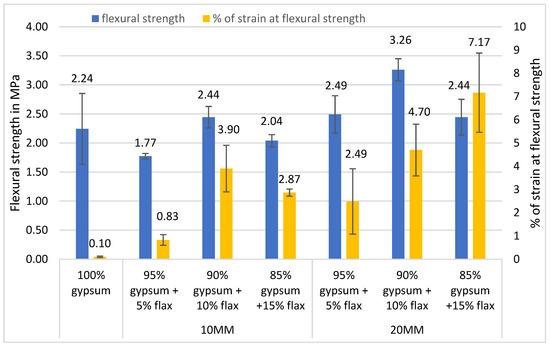
Figure 4.
Flexural strength comparison of different samples.
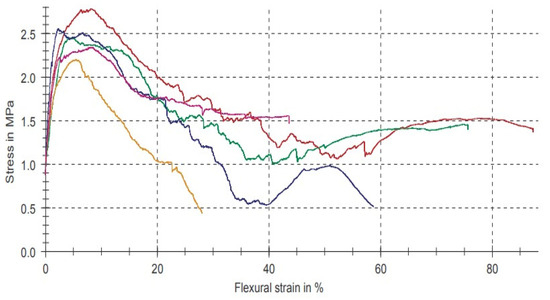
Figure 5.
Flexural test curve of 85% gypsum and 15% flax fiber composite with 20 mm fiber length.
3.2. Compression Test
Compression testing involves applying a compressive load to a material to measure its resistance to deformation under a compressive force. For flax–gypsum composites, a compression test is performed to evaluate their compressive strength, compressive modulus, and compressive strain. For 100% gypsum, the compression modulus is 18.87 MPa.
As the proportion of flax fiber increases in the composite, the compression modulus decreases. The compression modulus of 85% gypsum and 15% is 16.43 MPa and 29.40 MPa for both 10 mm and 20 mm length, but for 95% gypsum and 5% flax composite, the compression modulus is 20.1 MPa and 34.80 MPa, as shown in Figure 6.
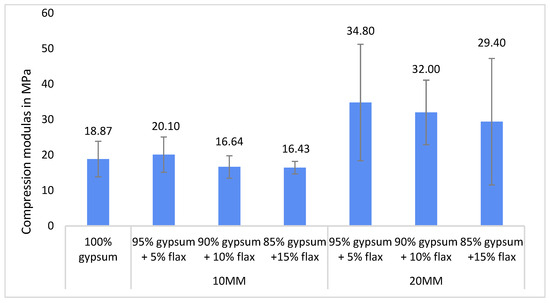
Figure 6.
Compression modulus comparison of different samples.
The increase in vol.-% of flax fiber resulted in an increase in compressive strength with a 10 mm fiber length and an increase up to 10% fiber loading, and a decrease with 15% fiber loading with a 20 mm fiber length. With a 10 mm fiber length, the fibers may be more uniformly distributed within the composite, leading to enhanced load-bearing capacity and improved compression strength. However, when using 20 mm fibers, achieving a uniform dispersion becomes more challenging, which leads to weaker areas and voids in the composite and, thus, a decrease in compression strength beyond 10% as shown in Figure 7 and Figure 8.
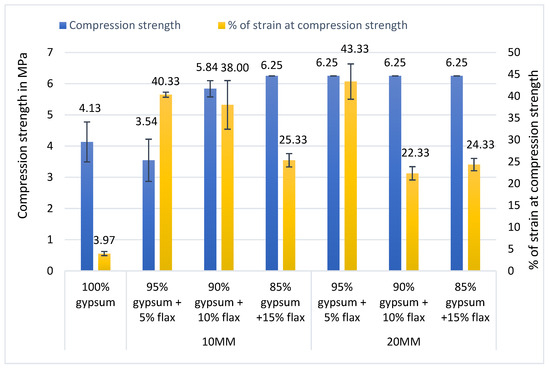
Figure 7.
Compression strength comparison of different samples.
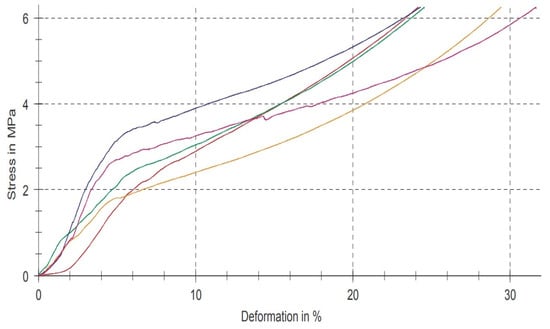
Figure 8.
Compression test curve of 85% gypsum and 15% falx fiber composite with 20 mm fiber length.
3.3. Density Tests
The density of 100% gypsum is 1.71 gm/cm3. Density decreases with an increase in fiber quantity in the composite; that is, 1.50 and 1.51 for 15% fiber quantity with both 10 mm and 20 mm fiber length, respectively as shown in Figure 9. Adding flax fibers reduces the composite density in proportion to the amount of fiber added. More fibers lower the density further.
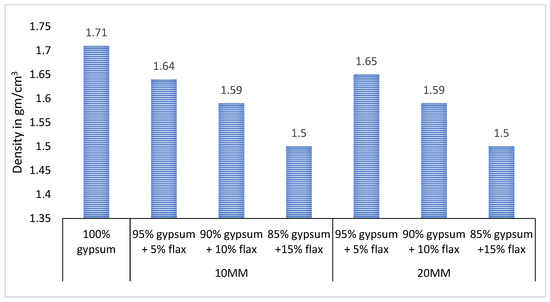
Figure 9.
Density comparison of different samples.
3.4. Water Absorption Tests
Water absorption tests help in evaluating the material’s resistance to water and can be essential in applications where exposure to moisture is a concern. The fiber percentage has an influence on the water absorption of gypsum composite samples at saturation time. The water absorption percentages change significantly between different quantities of fiber loading as well as across fiber lengths. The 100% gypsum absorbs water at a rate of 10.13% of weight in the first 24 h, 1.06% of weight in the second, and 0.47% of weight in the third. At 15% fiber loading, the maximum water absorption of flax fiber-reinforced gypsum composites is 31.28% and 33.31% for the first 24 h, 1.81% and 1.92% for the second 24 h, and 0.84% and 0.82% for the third 24 h with fiber lengths of 10 mm and 20 mm, respectively (from Figure 10).
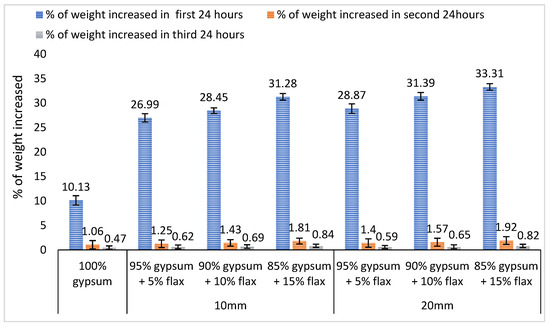
Figure 10.
Water absorption comparison of different samples.
3.5. Microscopy Test
In 100% gypsum, as shown in Figure 11, it is possible to observe small voids or pores within the crystal structure. These voids may result from the manufacturing process. During the manufacturing process or when gypsum is in a wet state, air bubbles can become trapped within the material. These air entrapments can create voids and affect the overall density and mechanical properties of the gypsum.
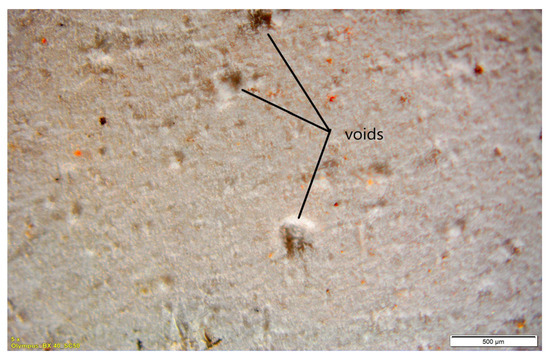
Figure 11.
Optical microscopy test image of 100% gypsum at 500 µm scale.
As shown in Figure 12a,d, microscopy revealed that the flax fibers in the composite are well distributed, and small voids and air entrapments can be observed within the gypsum matrix. The presence of voids affects density. The interface bonding between the fiber and matrix is crucial as it governs the load transfer and bonding between the two materials. As a well-bonded interface, it enhanced the composite’s mechanical properties.
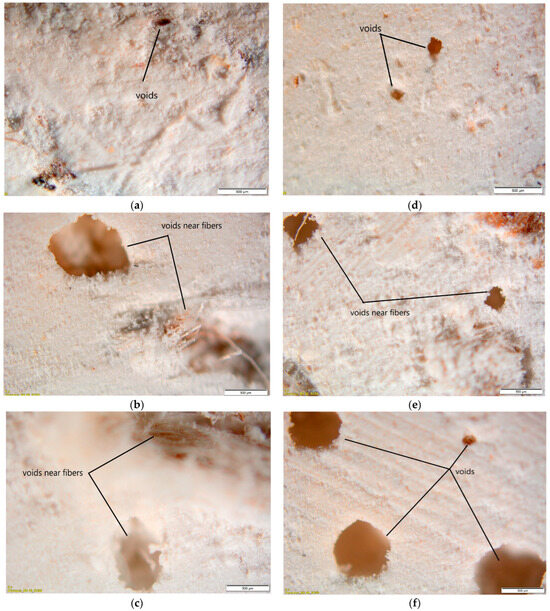
Figure 12.
(a) Optical microscopy test image of 95% gypsum and 5% flax (10 mm) at 500 µm. (b) Optical microscopy test image of 90% gypsum and 10% flax (10 mm) at 500 µm. (c) Optical microscopy test image of 85% gypsum and 15% flax (10 mm) at 500 µm. (d) Optical microscopy test image of 95% gypsum and 5% flax (20 mm) at 500 µm. (e) Optical microscopy test image of 90% gypsum and 10% flax (20 mm) at 500 µm. (f) Optical microscopy test image of 85% gypsum and 15% flax (20 mm) at 500 µm scale.
It can be seen in Figure 12b,e that voids and air entrapments in flax–gypsum composites with a composition of 90% gypsum and 10% flax can be created during the molding of the composite; air can be trapped between the fibers and within the gypsum matrix. The interface between the fiber and matrix is better, but not when compared with the lower-fiber-content composite.
As depicted in Figure 12c,f, it can be observed that flax–gypsum composites with higher fiber content, such as 85% gypsum and 15% flax, exhibit more voids and reduced strength due to the distribution of flax fibers within the gypsum matrix. Improper bonding between the flax fibers and the gypsum matrix can lead to less efficient stress transfer between the fibers and the matrix, so that the composite’s strength and load-bearing capacity are compromised.
4. Discussion
Flax fiber was used as a reinforcement for gypsum to develop gypsum-based composites with varying fiber contents to study the mechanical properties of gypsum in research works. The flax fibers were treated with a NaOH solution. Alkali treatment causes fibers to swell, which causes lignin to break down. Thus, the hydroxide ions target the carbon ester bonds between lignin, cellulose, and hemicellulose. Alkali treatment removes lignin and certain hemicelluloses by severing the links between lignin and polymer. Treatment with higher doses of NaOH weakens the fiber by attacking the cellulose fibrils and destroying the matrix [9].
The results revealed insights into the mechanical behavior of flax fiber-reinforced gypsum composites. The flexural modulus increases with the addition of flax fibers, up to a certain volume content (90% gypsum, 10% flax) for both fiber lengths. However, at higher flax fiber content (e.g., 15% flax), a decrease in flexural modulus was observed but was not significant. This finding underscores the need for an optimal balance between gypsum and flax fibers to achieve optimal mechanical characteristics. The increase in flax fiber content led to an enhancement in flexural strength; up to 10% fiber loading for both 10 mm and 20 mm fiber lengths can be seen in Figure 12c,f.
The compression modulus decreases with increasing flax fiber content. This reduction in modulus can be attributed to the displacement of gypsum by the fibers, resulting in a lower density of the composite [11]. Nevertheless, an increase in compressive strength was noted with 10 mm fiber length up to 10% fiber loading, whereas 20 mm fibers exhibited a decrease in strength beyond this point. This difference was attributed to the challenge of achieving uniform fiber dispersion in composites containing longer fibers, leading to voids and weaker areas in the material, as shown in Figure 12b,e.
The proportional reduction in density with increasing fiber content implies that these natural fibers possess a lower density compared to gypsum. This finding highlights the potential of flax fibers as lightweight reinforcement materials in composite manufacturing. However, it is worth noting that the presence of voids and air entrapments in samples with a high fiber content can limit the density. The water absorption properties of the composites showed significant variations with different fiber loadings and lengths. Notably, the introduction of flax fibers resulted in higher water absorption compared to pure gypsum. This behavior can be attributed to the inherently higher water absorption characteristics and hygroscopic behavior of flax fibers [16].
It was observed from microscopy that flax–gypsum composites with higher fiber content, such as 85% gypsum and 15% flax, as shown in Figure 12c,f, possessed more voids within the microstructure, obviously reducing the strength. The distribution of flax fibers within the gypsum matrix plays a vital role in the composite. From the microscopy and mechanical tests, it was observed that improper bonding between the flax fibers and the gypsum matrix leads to less efficient stress transfer between the materials, ultimately compromising the composite’s strength, load-bearing capacity, and density.
5. Conclusions
The composite’s mechanical characteristics were notably impacted by the quantity and length of flax fibers used. When a smaller amount of fiber was incorporated into the composite, it was evident that there existed a strong bond between the flax fiber reinforcement and the composite material’s matrix phase. As the fiber length increased, the composite exhibited ductile behavior compared to 100% gypsum. This enhanced bonding and the longer flax fibers (10 mm and 20 mm) contributed to improvements in both flexural and compressive strength.
The fiber lengths enhanced the mechanical properties, including flexural and compressive strength, of the gypsum matrix when they were added up to a certain volume percentage, which was 10%. However, it was observed that the 10 mm fibers were more uniformly distributed within the composite, which led to a better load-bearing capacity and improved compression strength. Up to a 10% volume loading of flax fibers, a positive effect was noted on both flexural and compressive strength. Due to these reasons, an optimal quantity of flax fibers in the range of 10% was compatible with gypsum and improved its mechanical properties.
Overall, the conclusions indicate that adding flax fibers to gypsum composites can indeed enhance their flexural and compressive strengths, but only up to a certain percentage of fiber loading. This optimal fiber content leads to improved mechanical properties due to proper bonding between the reinforcement fibers and the matrix. However, when the fiber content surpasses this optimal point, the mechanical properties start to deteriorate. Lower density in composites can have practical benefits, such as reduced weight and an improved strength-to-weight ratio. Depending on the application, these properties can be advantageous in industries like construction, automotives, and aerospace.
Future investigations will focus on refining manufacturing techniques to achieve superior fiber dispersion and alignment, especially at higher fiber loadings. By integrating advanced manufacturing methods and surface treatments for flax fibers, the objective is to optimize their interaction with gypsum, ultimately yielding superior composite materials. This exploration into enhanced compatibility and manufacturing processes holds the potential to revolutionize the practical applications of these composites across various industries.
Author Contributions
V.C. contributed to the data collection, synthesis and writing of the initial drafts of the manuscript. J.S. helped with research progress and reviewing the report. Methodology, V.C. and Y.P.S. Supervision J.S. and Y.P.S. helped with the report reviewing. All authors have read and agreed to the published version of the manuscript.
Funding
The APC was sponsored by Hochschule Kaiserslautern, whereas no external funding was provided for this research.
Data Availability Statement
Data are contained within the article.
Acknowledgments
The Institute for Plastics Engineering West Pfalz (IKW) is acknowledged by the authors for its financial assistance. It is research and testing facility run by the Department of Applied Logistics and Polymer Sciences at Hochschule Kaiserslautern, Pirmasens, Germany.
Conflicts of Interest
The authors declare no conflicts of interest.
References
- Li, X.; Tabil, L.G.; Panigrahi, S.; Crerar, W.J. The Influence of Fiber Content on Properties of Injection Molded Flax Fiber-HDPE. In Proceedings of the 2006 ASAE Annual Meeting (2006), Edmonton, AB, Canada, 16–19 July 2006. [Google Scholar]
- Jarukumjorn, K.; Suppakarn, N. Effect of glass fiber hybridization on properties of sisal fiber polypropylene composites. Compos. Part B Eng. 2009, 40, 623–627. [Google Scholar] [CrossRef]
- Shah, D.U. Developing plant fibre composites for structural applications by optimising composite parameters: A critical review. J. Mater. Sci. 2013, 48, 6083–6107. [Google Scholar] [CrossRef]
- Singh, N.B.; Middendorf, B. Calcium sulphate hemihydrate hydration leading to gypsum crystallization. Prog. Cryst. Growth Charact. Mater. 2007, 53, 57–77. [Google Scholar] [CrossRef]
- Sophia, M.; Sakthieswaran, N.; Ganesh Babu, O. Gypsum as a Construction Material—A Review of Recent Developments. Int. J. Innov. Res. Sci. Technol. 2016, 2, 1–9. [Google Scholar]
- Iucolano, F.; Liguori, B.; Aprea, P.; Caputo, D.; Colangelo, F. Recycled plastic aggregate in plastering mortars. Constr. Build. Mater. 2018, 131, 394–401. [Google Scholar]
- Bumanis, G.; Vitola, L.; Pundiene, I.; Sinka, M.; Bajare, D. Gypsum, Geopolymers, and Starch—Alternative Binders for Bio-Based Building Materials: A Review and Life-Cycle Assessment. Sustainability 2020, 12, 5666. [Google Scholar] [CrossRef]
- Gowthaman, S.; Nakashima, K.; Kawasaki, S. A State-of-the-Art Review on Soil Reinforcement Technology Using Natural Plant Fiber Materials: Past Findings, Present Trends and Future Directions. Materials 2018, 11, 553. [Google Scholar] [CrossRef] [PubMed]
- Thakur, A.K.; Schuster, J.; Shaik, Y.P. Fabrication and Characterization of Hybrid Bio-Composites Using Braided Natural Fibers and Aligned Thermoplastic Filaments. J. Compos. Sci. 2022, 6, 291. [Google Scholar] [CrossRef]
- Habibi, M.; Laperrière, L.; Lebrun, G.; Toubal, L. Combining short flax fiber mats and unidirectional flax yarns for composite applications: Effect of short flax fibers on biaxial mechanical properties and damage behaviour. Compos. Part B Eng. 2017, 123, 165–178. [Google Scholar] [CrossRef]
- Chinta, S.K.; Katkar, P.M.; Mirji, M.J. Natural fibres-reinforced in false ceiling. Int. J. Adv. Res. IT Eng. 2012, 1, 47–55. [Google Scholar]
- Hošťálková, M.; Vavřínová, N.; Longauerová, V. Mechanical properties of the gypsum composite reinforcement with wooden fibers. Int. Rev. Appl. Sci. Eng. 2019, 10, 15–21. [Google Scholar] [CrossRef]
- Wei, J.; Meyer, C.; Deglmann, P. Degradation mechanisms of natural fiber in the matrix of cement composites. Cem. Concr. Res. 2004, 34, 1595–1606. [Google Scholar] [CrossRef]
- Iucolano, F.; Liguori, B.; Caputo, D.; Colangelo, F.; Cioffi, R. Recycled plastic aggregate in mortars composition: Effect on physical and mechanical properties. Mater. Des. 2013, 52, 916–922. [Google Scholar] [CrossRef]
- Ali, M.; Liu, A.; Sou, H.; Chouw, N. Mechanical and dynamic properties of coconut fibre reinforced concrete. Constr. Build. Mater. 2012, 30, 814–825. [Google Scholar] [CrossRef]
- Ardanuy, M.; Claramunt, J.; Toledo Filho, R.D. Cellulosic fiber reinforced cement-based composites: A review of recent research. Constr. Build. Mater. 2015, 79, 115–128. [Google Scholar] [CrossRef]
- Nindiyasari, F.; Griesshaber, E.; Zimmermann, T.; Manian, A.P.; Randow, C.; Zehbe, R.; Fernandez-Diaz, L.; Ziegler, A.; Fleck, C.; Schmahl, W.W. Characterization and mechanical properties investigation of the cellulose/gypsum composite. J. Compos. Mater. 2016, 50, 657–672. [Google Scholar] [CrossRef]
- Ali, M.A.; Grimer, F.J. Mechanical properties of glass fiber-reinforced gypsum. J. Mater. Sci. 1969, 4, 389–395. [Google Scholar] [CrossRef]
Disclaimer/Publisher’s Note: The statements, opinions and data contained in all publications are solely those of the individual author(s) and contributor(s) and not of MDPI and/or the editor(s). MDPI and/or the editor(s) disclaim responsibility for any injury to people or property resulting from any ideas, methods, instructions or products referred to in the content. |
© 2024 by the authors. Licensee MDPI, Basel, Switzerland. This article is an open access article distributed under the terms and conditions of the Creative Commons Attribution (CC BY) license (https://creativecommons.org/licenses/by/4.0/).